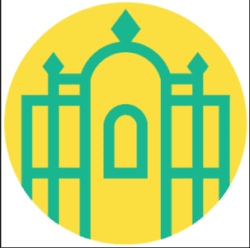Aztec Calendar Wheels, Central America, 1000 BCE
From 1000 BCE, most of Central America used similar types of calendars based on material objects and celestial constellations. The two most common calendars were the 260-day festival calendar and the 365-day solar calendar. The correlation between the two occurs every 52 years when both begin their new years. This is called the “Calendar Round” and the number became important in Central American cultures.
The 260-day calendar, called a tzolkin, consists of two wheels, a larger one of twenty days and a smaller one with the numbers one through thirteen. The number twenty was based on the digits of a “whole man” (i.e., fingers and toes) and the thirteen numbers represented their philosophy of thirteen directions in space. The early Central Americans believed that this ritualistic calendarrepresented an archetypal state of human and cosmic harmony.
Each rotation through the thirteen numbers represents one “week” in this system. The first, sixth, eleventh, and sixteenth weeks were special and very important; they created the four divisions of their year. Each of the twenty days was associated with tangible objects or animals and a deity. This created a sort of permanent fortune-telling machine and guided their destinies.
Method of Construction
Constructed by: Kate McCloskey ’97
The first step in making the calendar wheels is to cut two 3/4-inch-thick boards into a 25 cm square (for the large days wheel) and a 15 cm square (for the small number wheel). Next, find the center of each board and drill a half-inch hole. From the center of the large wheel, drill twenty half-inch holes around a circle of radius 10.75 cm; they should be spaced about 18 degrees apart when finished. From the center of the small wheel, drill thirteen half-inch holes around a circle of radius 7.31 cm; they should be spaced about 27.7 degrees apart when finished. Then cut the two squares into circles of radius 10.75 cm (large) and 7.31 cm (small), which should cut the drilled holes in half. Next, cut twenty half-inch dowel pegs 3/4 inches in length which are then glued into the indentations (left by the drill holes) in the large wheel. The two wheels are then attached by placing a half-inch dowel rod in the center of each wheel and then through a 18.25 cm board, allowing the small wheel to rotate around the large one to count the days of the week.
Sources, Resources and Links
Nuttal, Z. “The Fundamental Principles of Old and New World Civilizations.” Archaeological and Ethnological Papers of the Peabody Museum, v. 2. Salem, MA: The Salem Press Co., 1900.
Seler, E. “The Day Gods of the Mayas.” Mexican and Central American Antiquities, Calendar Systems, and History.
Ed. Bowditch, C. P. Washington, DC: Washington Government Printing Office, 1904.




